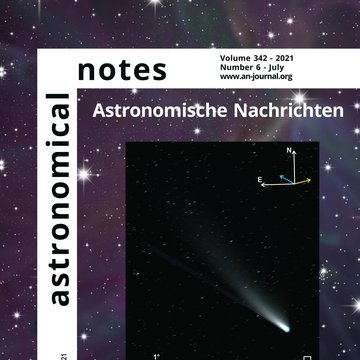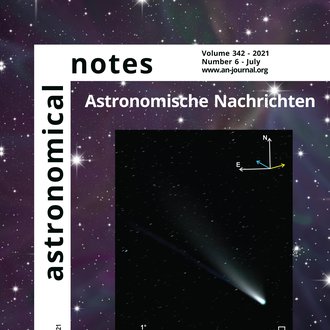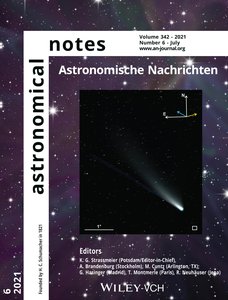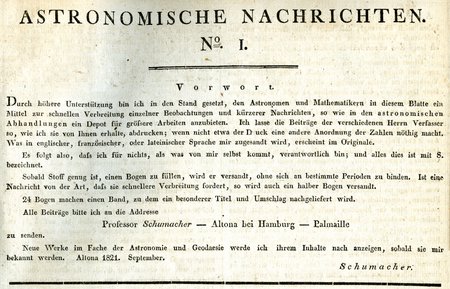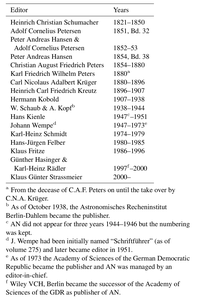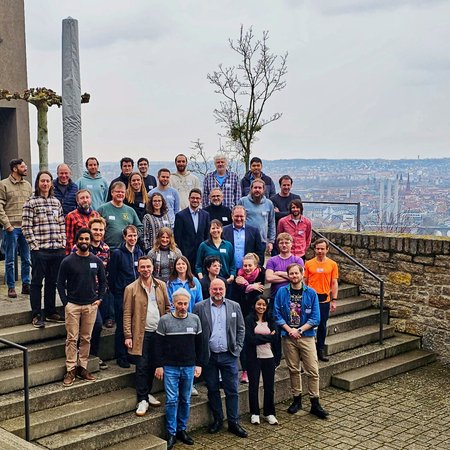Happy Birthday: Astronomical Notes turn 200
The astronomical journal Astronomische Nachrichten/Astronomical Notes (AN) was founded by H. C. Schumacher in 1821 and thus turns 200 years old in 2021. It is the oldest astronomical journal in the world that is still being published.
“A long time ago the possibilities for publishing astronomical observations and results were completely different from today’s practice. But already in the 15th century it was astronomy which was closely connected to the publication of periodically published scientific works”, as Prof. Dr. Klaus Strassmeier resumes. He is director of the Leibniz Institute for Astrophysics Potsdam (AIP) and has been Editor-in-Chief of Astronomische Nachrichten since 2000.
The “Astronomische Jahrbücher” (Annual Astronomical Books), published from 1450 to 1461, and the “Ephemeriden” (Ephemerides), published from 1475 to 1506, are the oldest periodical gazettes in the world. The first astronomical journal – the “Astronomische Nachrichten” (Astronomical Notes) – was founded in 1821, only 370 years later. That year, Heinrich Christian Schumacher, at the instigation of the Danish king Frederik VI, was asked by the Danish minister of finance to publish an astronomical bulletin which should foster international cooperation. Although founded in 1821, it was not until two years had passed that the first issue of AN was ready and had been published. Already in the first issue, an article by Carl-Friedrich Gauss on the „Anwendung der Wahrscheinlichkeitsrechnung auf ein Problem der practischen Geometrie“ ("Application of the Probability Theory to a Problem of Practical Geometry") was presented, which was well received in the community.
In his introduction in the first issue, Schumacher briefly outlined the aim of the journal: “To publish a means for the quick circulation of single observations and short news as well as astronomical and mathematical works and treatises.”. The original articles were published in German, English, French, and Latin language. The journal was meant to be open to all and have a high frequency of publication; the publication of articles was to be free of charge for the scientists. This month, the sixth issue of volume 342 appeared, exactly 200 years after Schumacher started with issue 1 of volume 1. Today, AIP hosts the editorial office, in close collaboration with Wiley-VCH. Last year's volume of AN contained over 90 peer-reviewed research articles, totaling more than 1000 pages. Astronomical Notes now covers a wide range of topics, from instrument projects and observing campaigns to theoretical studies and numerical simulations.
Schumacher was based in Altona near Hamburg and led the journal for 30 years until his death in December 1850. He passed the editorial work on to Christian August Peters. After the death of Christian August Peters in 1880, the magazine went into the public ownership of the Prussian government. All science-related issues were ruled by the “Astronomische Gesellschaft” (German Astronomical Society) founded in 1863, among them the appointment of Carl Nicolaus Adalbert Krüger as the new Editor-in-Chief of AN. Under Krüger’s management, and due to an agreement with the German Astronomical Society, the international character of the journal was encouraged and emphasised. As a consequence, the 40 issues published by Krüger contain a high percentage of international papers. In the course of the dissolution of the Kiel University Observatory, the editorial office moved to the “Astronomisches Recheninstitut” (Astronomical Computing Center) in Berlin-Dahlem in 1938. Due to the war, the editorial office ceased daily operations of the AN in December 1943 and moved out of the city to Potsdam.
Since 1947, the editorial office has been located in Potsdam, at that time still at the Astrophysical Observatory Potsdam. The publication of the journal was taken over by the Akademie Verlag of the GDR on behalf of the German Academy of Sciences at Berlin. After the reunification, the journal became part of the Wiley-VCH portfolio.
To reflect its international character, the journal changed its main title to Astronomical Notes in 2005, but retained Astronomische Nachrichten as subtitle. Since 1999, the journal has been published in electronic form. Today, a convenient online submission system, open access supported by Projekt DEAL in Germany and many national and funder agreements as well as modern article formats on Wiley Online Library are available.
The astronomical journal Astronomische Nachrichten/Astronomical Notes (AN) was founded by H. C. Schumacher in 1821 and thus turns 200 years old in 2021. It is the oldest astronomical journal in the world that is still being published.
“A long time ago the possibilities for publishing astronomical observations and results were completely different from today’s practice. But already in the 15th century it was astronomy which was closely connected to the publication of periodically published scientific works”, as Prof. Dr. Klaus Strassmeier resumes. He is director of the Leibniz Institute for Astrophysics Potsdam (AIP) and has been Editor-in-Chief of Astronomische Nachrichten since 2000.
The “Astronomische Jahrbücher” (Annual Astronomical Books), published from 1450 to 1461, and the “Ephemeriden” (Ephemerides), published from 1475 to 1506, are the oldest periodical gazettes in the world. The first astronomical journal – the “Astronomische Nachrichten” (Astronomical Notes) – was founded in 1821, only 370 years later. That year, Heinrich Christian Schumacher, at the instigation of the Danish king Frederik VI, was asked by the Danish minister of finance to publish an astronomical bulletin which should foster international cooperation. Although founded in 1821, it was not until two years had passed that the first issue of AN was ready and had been published. Already in the first issue, an article by Carl-Friedrich Gauss on the „Anwendung der Wahrscheinlichkeitsrechnung auf ein Problem der practischen Geometrie“ ("Application of the Probability Theory to a Problem of Practical Geometry") was presented, which was well received in the community.
In his introduction in the first issue, Schumacher briefly outlined the aim of the journal: “To publish a means for the quick circulation of single observations and short news as well as astronomical and mathematical works and treatises.”. The original articles were published in German, English, French, and Latin language. The journal was meant to be open to all and have a high frequency of publication; the publication of articles was to be free of charge for the scientists. This month, the sixth issue of volume 342 appeared, exactly 200 years after Schumacher started with issue 1 of volume 1. Today, AIP hosts the editorial office, in close collaboration with Wiley-VCH. Last year's volume of AN contained over 90 peer-reviewed research articles, totaling more than 1000 pages. Astronomical Notes now covers a wide range of topics, from instrument projects and observing campaigns to theoretical studies and numerical simulations.
Schumacher was based in Altona near Hamburg and led the journal for 30 years until his death in December 1850. He passed the editorial work on to Christian August Peters. After the death of Christian August Peters in 1880, the magazine went into the public ownership of the Prussian government. All science-related issues were ruled by the “Astronomische Gesellschaft” (German Astronomical Society) founded in 1863, among them the appointment of Carl Nicolaus Adalbert Krüger as the new Editor-in-Chief of AN. Under Krüger’s management, and due to an agreement with the German Astronomical Society, the international character of the journal was encouraged and emphasised. As a consequence, the 40 issues published by Krüger contain a high percentage of international papers. In the course of the dissolution of the Kiel University Observatory, the editorial office moved to the “Astronomisches Recheninstitut” (Astronomical Computing Center) in Berlin-Dahlem in 1938. Due to the war, the editorial office ceased daily operations of the AN in December 1943 and moved out of the city to Potsdam.
Since 1947, the editorial office has been located in Potsdam, at that time still at the Astrophysical Observatory Potsdam. The publication of the journal was taken over by the Akademie Verlag of the GDR on behalf of the German Academy of Sciences at Berlin. After the reunification, the journal became part of the Wiley-VCH portfolio.
To reflect its international character, the journal changed its main title to Astronomical Notes in 2005, but retained Astronomische Nachrichten as subtitle. Since 1999, the journal has been published in electronic form. Today, a convenient online submission system, open access supported by Projekt DEAL in Germany and many national and funder agreements as well as modern article formats on Wiley Online Library are available.
Images
Front cover AN issue 6 volume 342, July 2021.
Big screen size [1000 x 1313, 160 KB]
Original size [2483 x 3261, 420 KB]
Preface of AN volume 1, number 1 from H.C. Schumacher.
Big screen size [1000 x 643, 180 KB]
Original size [4756 x 3060, 1.9 MB]
Table with publishers and editors of AN.
Big screen size [1000 x 1517, 560 KB]
Original size [1056 x 1602, 290 KB]
